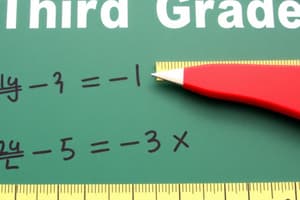Podcast
Questions and Answers
What is a similarity between multiplying and dividing measurements?
What is a similarity between multiplying and dividing measurements?
- You cannot multiply or divide measurement units that are completely different.
- You need to have the same measurement units.
- You can multiply or divide measurement units that are completely different. (correct)
- You can multiply or divide measurement units in the same way you add and subtract them.
What happens to the measurement units when you multiply a measurement by a number?
What happens to the measurement units when you multiply a measurement by a number?
- They are converted to a different unit.
- They cancel out.
- They are converted to the same unit.
- They stay the same. (correct)
What should you do if you have a measurement that consists of both feet and inches and you need to divide?
What should you do if you have a measurement that consists of both feet and inches and you need to divide?
- Cancel out one unit.
- Change one unit to the other.
- Leave the measurement as it is.
- Convert it into a decimal. (correct)
What is the result of dividing 6 inches by 3?
What is the result of dividing 6 inches by 3?
What is the unit of the answer when dividing 70 miles by 2 hours?
What is the unit of the answer when dividing 70 miles by 2 hours?
Why do you keep the measurement units as a fraction when finding the speed of a car?
Why do you keep the measurement units as a fraction when finding the speed of a car?
What happens to the measurement units when dividing different measurement units?
What happens to the measurement units when dividing different measurement units?
What is an example of multiplying two different measurement units?
What is an example of multiplying two different measurement units?
Why do you convert measurement units to the same unit when adding and subtracting?
Why do you convert measurement units to the same unit when adding and subtracting?
What happens to the units when you divide a measurement by a number?
What happens to the units when you divide a measurement by a number?
Flashcards are hidden until you start studying
Study Notes
Measurements Are Like Variables
- Measurements can be treated as variables when performing operations such as adding, subtracting, multiplying, and dividing.
- This is important in real-life problems that involve measurements, such as in restaurant management.
Adding Measurements
- To add measurements, ensure that the measurement units are the same.
- If the units are the same, add the numbers together, e.g., 3 feet + 4 feet = 7 feet.
- If the units are different, convert one unit to match the other before adding, e.g., 3 feet + 36 inches = 3 feet + 3 feet = 6 feet.
Subtracting Measurements
- To subtract measurements, ensure that the measurement units are the same.
- If the units are the same, subtract the numbers together, e.g., 10 feet - 7 feet = 3 feet.
- If the units are different, convert one unit to match the other before subtracting, e.g., 10 feet - 120 inches = 10 feet - 10 feet = 0 feet.
Multiplying Measurements
- To multiply measurements, ensure that the measurement units are in the same unit or can be converted to the same unit.
- Multiply the numbers together, e.g., 7.5 feet * 10 feet = 75 square feet.
- The resulting unit will be the product of the original units, e.g., feet * feet = square feet.
- Unlike addition and subtraction, different measurement units can be multiplied together.
Dividing Measurements
- To divide measurements, ensure that the measurement units are in the same unit or can be converted to the same unit.
- Divide the numbers together, e.g., 6 inches ÷ 3 = 2 inches.
- The resulting unit will stay the same if dividing by a number, but may change if dividing by a different unit, e.g., 70 miles ÷ 2 hours = 35 miles per hour.
- Unlike addition and subtraction, different measurement units can be divided together.
Studying That Suits You
Use AI to generate personalized quizzes and flashcards to suit your learning preferences.




